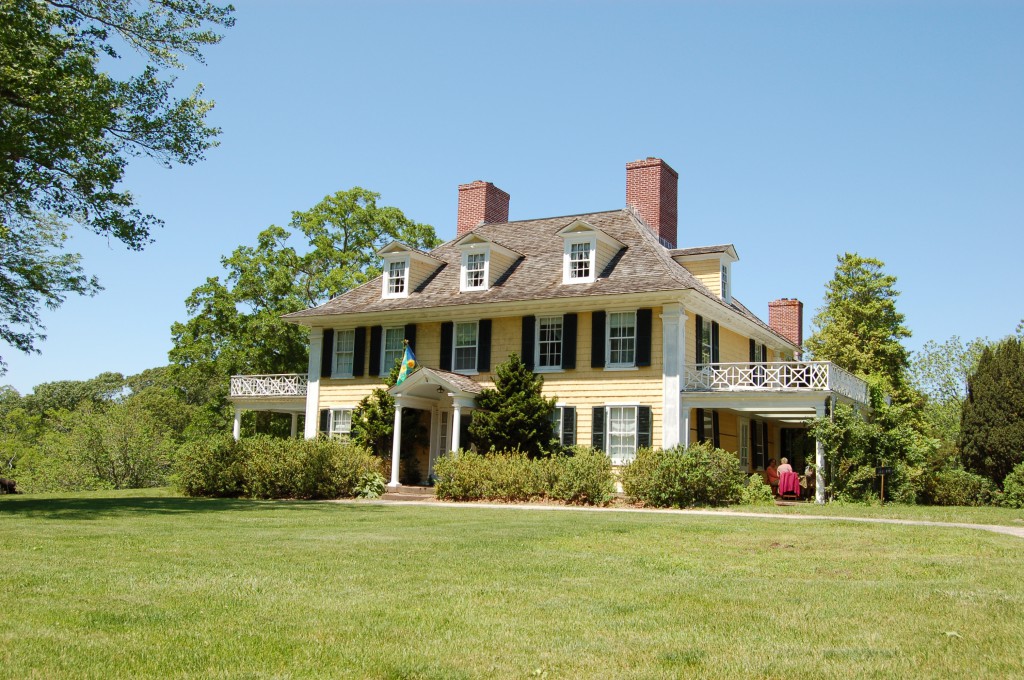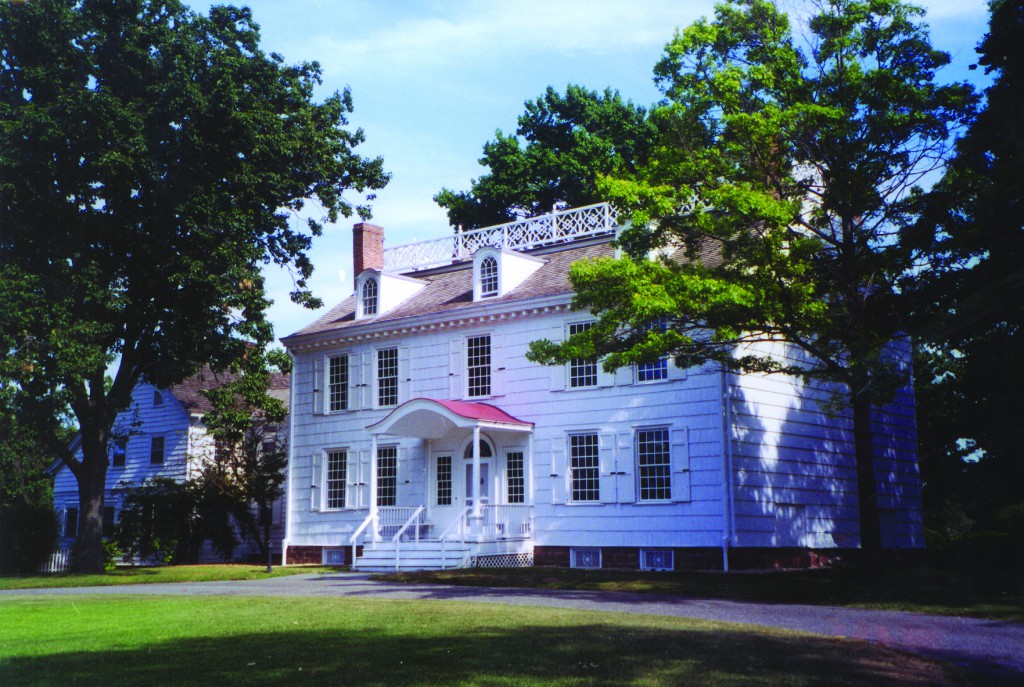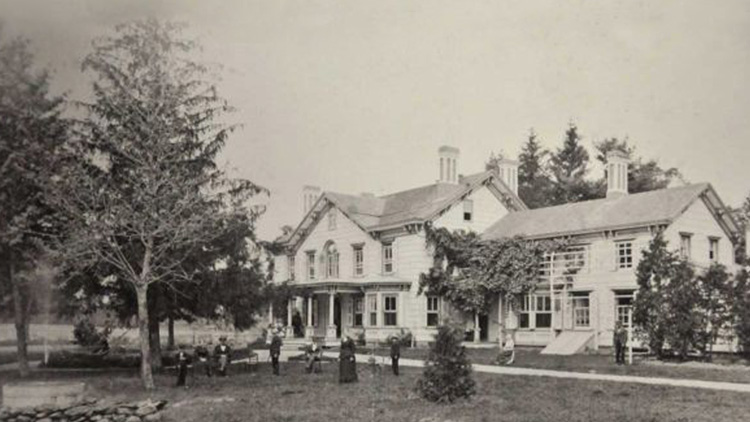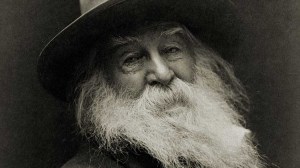By the light of single match a group of shadowy figures followed a path that would take them under the cover of darkness from their hiding place in the attic of a Quaker house in Old Westbury, through the fields, to a waiting boat in Roslyn Harbor, where they’d quietly board and hope to cross the Sound safely on their way to freedom. A cough or a sneeze could be suicide. Rachael Hicks, born there in 1857, wouldn’t learn about her own family’s role in Long Island’s Underground Railroad until her older siblings told her about it after the Civil War had ended.
Another key way station in Jericho also held its secrets. Known to us today as the Maine Maid Inn, it was once the home of the Quaker abolitionist Valentine Hicks and his wife Abigail, whose father Elias Hicks had been the spark that helped convince Quakers and other like-minded people after the Revolutionary War that all men were created equal—including people of color who were enslaved.
“Elias spread the word and Valentine made the connection,” says Kathleen G. Velsor, a professor in the school of education at SUNY-Old Westbury and author of The Underground Railroad on Long Island, which came out last year. She said that a removable panel behind an upstairs linen closet at the Maine Maid Inn concealed a staircase to the attic where Hicks hid runaways until the coast was clear—and it’s still there today. The Town of Oyster Bay designated the site as an historic landmark in 2012.
How many enslaved people used Long Island to escape their chains may never be answered with certainty. Quakers and other abolitionists didn’t advertise their undertakings. But the numbers had to be relatively small. According to the National Park Service, which oversees the National Underground Railroad Network to Freedom, only 1,000 or so people a year came north, and Long Island was not on the direct route to Canada. But was it more than a detour?
Velsor insists that the Island was actually an important destination, albeit a temporary one, because the Quaker “conductors” of the Underground Railroad, which was neither a real railroad nor a tunnel underground, used their Long Island Society of Friends to help the fugitives “hide in plain sight,” dispersed among different homesteads beyond the reach of the slave catchers until they could move “up the trail.”
Unfolding this chapter of our Island’s history has been daunting for Velsor, because documents are scarce and skepticism abounds. One local librarian once condescendingly responded to her query thusly: “Don’t be silly, dear! There was no Underground Railroad here because there was no slavery on Long Island.”
So, in keeping with Black History Month, a little lesson is in order.
Of Human Bondage
“Slavery was widespread on Long Island,” says Christopher Matthews, an anthropology professor at Montclair University who has done extensive research on this topic. “It was the principal basis of the economy in the 18th century.”
Between 1619 and 1850, an estimated 12 million Africans were shipped across the Atlantic. Of this staggering amount of human cargo, about 5 percent ended up in North America. In the colonial era, historians say that New York City had the second-largest urban slave population after Charleston, S.C. On Long Island in 1771, 17 percent of the population was black and virtually all were enslaved. By 1790, when the first federal census was taken, 54.8 percent of Suffolk County slave owners had one slave, and 88.7 percent owned fewer than five.
The first—and the largest—slave plantation on Long Island had begun on Shelter Island in 1651 when Nathaniel Sylvester, an Englishman raised in Amsterdam, brought 24 slaves to work the land so he could provide for his brother’s sugar plantation in Barbados. Today the Sylvester Manor is the Sylvester Manor Educational Farm, a nonprofit foundation, as well as the subject of a fascinating account of American history, The Manor: Three Centuries at a Slave Plantation on Long Island, by Mac Griswold, a cultural landscape historian and Guggenheim Fellow. Her book, published in 2013 and now in its third printing and soon to be out in paperback, is the featured selection for “Long Island Reads,” the Island-wide reading initiative sponsored in April by the Nassau Library System and the Public Libraries of Suffolk County.

Back in 1984, Griswold and a friend were rowing a dinghy down Gardiners Creek when she spotted boxwoods looming over a garden by a yellow mansion. She judged by their huge size that these shrubs must have been hundreds of years old. She was right, as she later learned when she met the couple living there who subsequently pointed out the “slave staircase” leading from the west parlor to the attic. But Griswold didn’t start her research until 1997, after she’d written Washington’s Gardens at Mount Vernon, which drew her back to Shelter Island.
“Every time Washington said ‘I’ in his account book and in his journal,” she tells the Press, “he didn’t mean: ‘I graded the lawn,’ or ‘I chopped the trees’… He meant the 300 people who were working for him for free.”
Nathaniel Sylvester had employed a smaller workforce when he owned all 8,000 acres of Shelter Island. Today only 243 acres of his holdings remain and his original house is most likely under the foundation of the stately structure built in 1737 by his grandson, Brinley Sylvester, and renovated in the 1840s. But inside its walls Griswold found precious paperwork dating back centuries, such as Nathaniel’s will, which referred to his slaves by name, and his inventory, which listed them by value. Griswold also found a note written to Brinley in 1719 that he still owed the vendor money for “rum, molasses, and negros.”
Interestingly, Nathaniel Sylvester and his wife Grizzell were Quakers, but, as Griswold writes, that “does not seem to have made them sensitive to the plight of their slaves.” Researchers who have been conducting fieldwork at the site off and on for almost 15 years have discovered that this plantation did not fit the Southern stereotype. In fact, Native Americans, Africans, and whites lived and worked closely together.
Katherine Hayes, a University of Minnesota anthropology professor who will be returning to the manor later this spring to conduct an archaeological dig there, used an analogy by the historian Ira Berlin to distinguish between what he called “slave societies,” such as the sugar plantations in Barbados (or the Louisiana hellhole in the Oscar-nominated movie 12 Years a Slave), and “societies with slaves” like the manor on Shelter Island.
“Slave societies are entirely dependent on the institution of slavery,” says Hayes, author of Slavery Before Race: Europeans, Africans, and Indians at Long Island’s Sylvester Manor Plantation, 1651-1884. “That’s why slavery becomes such a cruel institution.” Societies with slaves were more like a class system, she explains.
“With slave societies, if you’re born a slave, your child is a slave,” Hayes says. “It runs in the family. Whereas in societies with slaves, there’s the possibility that your children will not be slaves, or that one day you may not be a slave as well.”
As for why the slaves on Shelter Island didn’t turn on their outnumbered masters, she says the threat of punishment was always present, but seldom necessary.
“Just hauling someone across the ocean and putting them in unfamiliar circumstances—you put them at a severe disadvantage without ever having to beat them,” she says.
Anthropologist Christopher Matthews found a similar pattern of mixed races working together in Hempstead at the Rock Hall Museum in Lawrence, formerly a 600-acre estate built in 1767 by Josiah Martin, a wealthy British sugar merchant from Antigua, who had the most slaves on a single plantation in what was then Queens. Last year in Stony Brook University’s Long Island History Journal, Matthews published an article with fellow researcher Ross Thomas Rava on their findings that the African slaves “actively participated in the construction and culture of the household rather than merely living and working there.”
“These people came to an accommodation with each other,” Griswold tells the Press. “We have to consider the whole story of slavery as an American story, not as an African-American story.”

Road to Freedom
Not too long ago, slavery was the norm. As Shelter Island’s Lodowick Havens, born in 1774, wrote in his memoir about the 1700s, “In them days all kept slaves as could afford it.”
This entrenched American institution had only begun to be challenged when the Quakers became the first organized group of whites here to voluntarily forswear slavery in the 18th century. And Long Island’s Elias Hicks and his son-in-law Valentine were among the most active in this movement. But their efforts and those of other abolitionists took a long while—not to mention a Civil War—to produce their desired results.
Joysetta Pearse, executive director of the African Museum of Nassau County, credits Long Island’s Quakers with being instrumental in hastening the end of slavery, at least up North.
“If an editor of a local paper ran an ad for a runaway slave—and slaves did run away from Long Island slaveholders—Long Island Quakers would write to the editors that they would boycott the papers if the editors continued to run the slave notices… They did all the harassing they could do, and the [state] legislature finally moved to address the issue.”
Under pressure, New York’s legislature amended its gradual manumission law in 1817 so that all enslaved blacks would be free as of 1827. As is so often true in this republic when reforms are passed, the drafters of the original bill had wanted to make sure the property owners were adequately compensated—even if their property was human chattel. Afterwards, abolitionists turned their attention to the slave states.
And given how the stakes changed for the operators of the Underground Railroad in 1850 after the passage of the Fugitive Slave Act, which mandated the return of runaway slaves wherever in the Union they might be, it became very dangerous for both slaves and their “conductors.”
“They couldn’t trust anybody,” says Velsor with admiration. “And that’s when you realize how heroic these people are.”
Mac Griswold, the author of The Manor, will be speaking about her book on Feb. 9 and Feb. 21 at 2 p.m. at the WMHO Educational and Cultural Center, 111 Main St., Stony Brook. Admission is free. For more information, call 631-751-2244 or go to www.wmho.org. The nationally acclaimed photographer Xiomaro, whose series on the slaves’ burial ground at the William Floyd Estate is currently on display at the African Burial Ground National Monument in New York City, will be giving a free lecture at the Oyster Bay Historical Society, 20 Summit St., Oyster Bay, on Feb. 9 at 2 p.m. Call 516-922-5032 for more information.



























